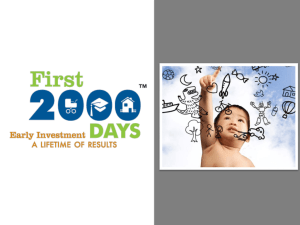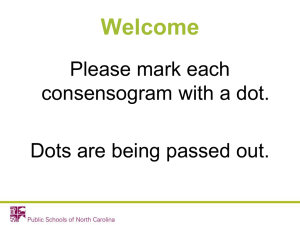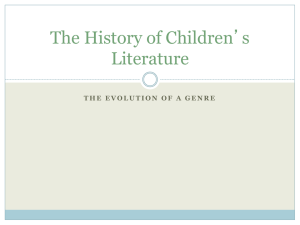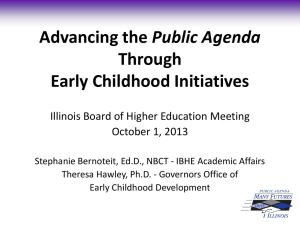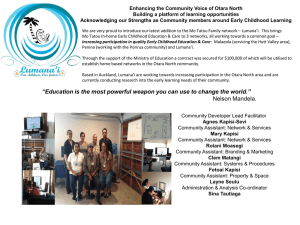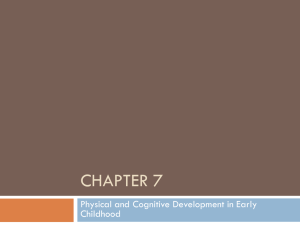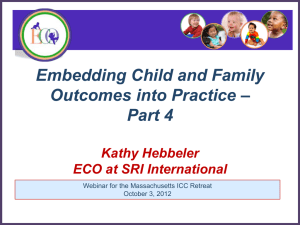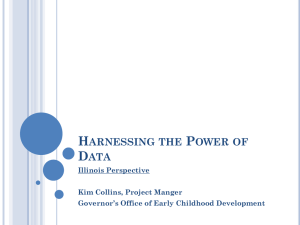Training Presentation for the Resource Manual for Administrators
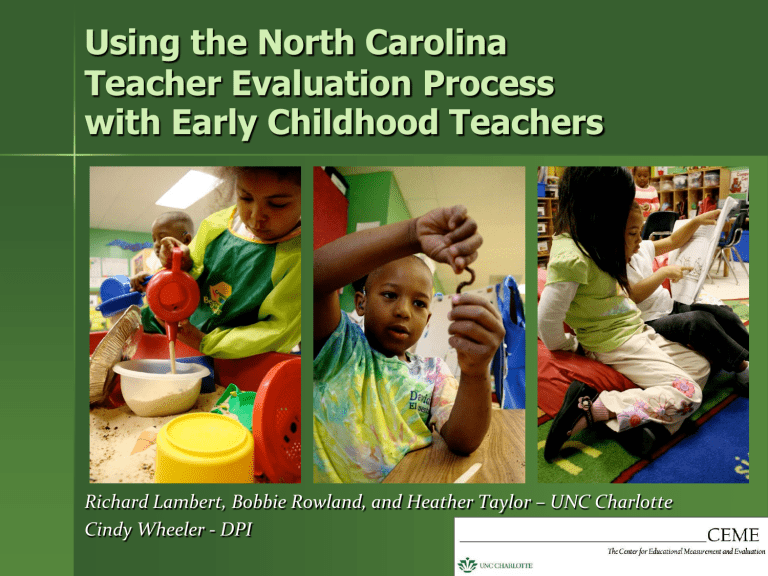
Using the North Carolina
Teacher Evaluation Process with Early Childhood Teachers
Richard Lambert, Bobbie Rowland, and Heather Taylor – UNC Charlotte
Cindy Wheeler - DPI
Acknowledgements
The following organizations made the new North Carolina Teacher
Evaluation Process possible:
McREL
North Carolina State Board of Education
North Carolina Professional Teaching Standards Commission
Funding and support for the manual was provided by the:
North Carolina Office of Early Learning, Teacher Licensure Unit
North Carolina DPI, Division of Educator Recruitment and
Development
To access the manual electronically: http://www.ncprek.nc.gov/TLU/tluInfoforEvaluatorsasp.asp
Introducing the Manual
Resource Manual for Administrators and Principals Supervising and
Evaluating Teachers of Young Children
A Supplementary Manual to Support the Evaluation of Teachers of Young
Children, Specifically Pre-K and Kindergarten Teachers Who are Required to Hold and Maintain a NC Teaching License, While Teaching in Public or Nonpublic Schools
The Manual
Agenda for Today
Purpose of the Manual
Core Beliefs about Early Childhood Education
Overview of Specific Sections of the Manual
Review of the Key components of the NC TEP
Sample Evidences for Specific Elements
Purpose of the Manual
To offer examples of how the North Carolina Teacher
Evaluation Process (NC TEP) can be translated into indicators of high quality teaching in early childhood settings
To illustrate how the NC TEP can be used to promote the professional development of early childhood teachers
To outline the procedures and identify resources for using the NC TEP with early childhood teachers in public and nonpublic settings
Purpose of the Manual
To help make the NC TEP easier to apply in early childhood settings
The manual offers resources to the early childhood education community that are useful
Across settings - Public and nonpublic settings
Across grade levels - Pre-k and Kindergarten
Across roles - Administrators, principals, teachers, mentors, evaluators, coaches, facilitators, etc.
Purpose of the Manual
To be responsive to the expanding demand for early education and the expanding role of early childhood principals, administrators, and teachers
As society expects more from early childhood education, and families are seeking high quality early education experiences for their children that are based on current research, the field is focusing on quality improvement
Quality improvement can help make a stronger connection between early childhood experiences and later school success
About the Manual
Section I – Introduction
Section II – Overview of the Evaluation Process
Section III – Key Principles of Early Childhood Education
Section IV – Resources
Section V – Teacher Behaviors, Child Behaviors, Classroom
Conditions, and Artifacts
Section VI – Tips for Evaluators
Section VII – Evidence Summary Sheets
Discussion Question
Take a minute to discuss what effective performance evaluation feedback to early childhood teachers would include?
Send some comments through the Question function that summarize your discussion.
Key Assumptions
Effective teacher performance evaluation facilitates communication of the Standards and Elements in the NC
TEP in a way that is
meaningful
and
relevant
to early childhood teachers
Effective performance evaluation provides useful and practical suggestions for improvements to early childhood teaching practices
Effective performance evaluation leads to targeted professional development goals based on observational data
Key Assumptions
Effective teacher performance evaluation facilitates a career long process of growth and development
High quality teachers consistently reflect on both the professional teaching standards and student learning standards for their specialty and how they relate to instruction in their classrooms
All teachers can learn to be reflective about their professional practice
Key Assumptions
Effective performance evaluation feedback helps teachers understand how to facilitate and enhance child development and learning
All teachers can take responsibility for their own professional growth and development and show leadership in the evaluation process by presenting artifacts and evidences of their teaching successes
Principals and administrators are seeking help in understanding what a high quality early childhood classroom looks like
Key Principles of Early Education
Early childhood is a unique time of life that warrants respect in its own right
Early education needs to take into account the whole child
Play is integral to young children’s language and development
Children are individuals
Key Principles of Early Education
Relationships are the foundation on which learning builds
Children’s language and culture are fundamental to who they are
Families are children’s first teachers and are important partners in children’s education
Early childhood educators are decision makers
Overview of Section II
On page 13 in your manual
Let’s look together at the NC TEP evaluation procedures.
The Manual
Overview of Section IV
On page 31 in your manual
Let’s look together at some resources that will be helpful to use during the evaluation process.
The Manual
Reviewing the NC TEP
An evaluation system – not an encouragement system
Focuses on professional growth – not compliance
Holistic scoring system – not an analytic scoring system
Review the NC TEP
Summative ratings – supported by formative evidences
Useful for professional development, training, and planning, - not just a necessary hurdle
Has an impact on child development and learning – but is not a quick fix or magic bullet
page 113 in the manual
Standard 1
Demonstrates Leadership
North Carolina Teacher Evaluation Process - Evidences Summary Sheet
Standard 2
Respectful Environment
Standard 3
Content
Standard 4
Facilitates Learning
a. Leads in the classroom a. Nurturing relationships a. Aligns with NCSCOS
(F o unda tio ns Ea rly le a rning S ta nda rds a nd/o r Kinde rga rte n S C OS )
Standard 5
Reflective Practice
a. Knows learning & development a. Analyzes student learning
b. Plans instruction
b. Leads in the school b. Embraces diversity b. Knows teaching speciality b. Professional growth goals
c. Variety of instructional methods
c. Adapts to change c. Leads in the profession
d. Advocate for students/schools
c. Treats students as individuals c. Interconnectedness of content d. Uses technology
d. Adapts for special needs d. Makes instruction relevant
e. Critical-thinking
f. Students work in teams
e. High ethical standards e. Works with families g. Communicates effectively
h. Assessment methods
Focal Elements for Observation Focal Elements for Observation Focal Elements for Observation Focal Elements for Observation Focal Elements for Observation
Rubric - Developing Proficient Accomplished Distinghished Evidences - Student Behaviors Teacher Behaviors Artifacts Classroom Conditions
Making Ratings
Albert Einstein had a sign hanging in his office at
Princeton that read “Not everything that counts can be counted, and not everything that can be counted counts.”
The most important tasks you perform as an evaluator are making holistic ratings on the rubric.
The ratings are intended to be rooted in a holistic synthesis of the total evidences gathered, based on professional judgment and training, and not a simple mathematical formula or summation of points on a checklist.
Making Ratings
Remember that the NC TEP is based on holistic scoring, not analytic scoring. An analytic scoring system would require the evaluator to add up or average across indicator ratings to create a total quantitative score.
Holistic scoring considers all of the evidence simultaneously and in total, and leads to a summary qualitative judgment about the current state of performance using the rubric.
Making Ratings
Remember that teachers develop at different rates.
Teachers may reach Proficient status earlier for some
Standards than others and do not have to receive the same summative ratings on all Standards.
Teachers move up in rating on a particular Standard only when all Elements within that Standard are rated at the respective level in question.
Defining the Rubric
Developing –
Awareness and Interest
Developing teachers are generally early in their careers.
However, teachers may reach proficiency for each of the standards at different rates. Teachers functioning at the developing level on a particular standard are expressing
Awareness and Interest
concerning relevant areas of professional functioning and effectiveness. Successful teachers at the developing level ask questions, think about what they do not yet know enough about, and pursue resources that can help them expand their knowledge and skills.
Discussion Question
Take a minute a discuss what a
Developing
early childhood teacher looks like in your setting.
Send some comments through the Question function that summarize your discussion.
Defining the Rubric
Proficient –
Intentionality and Consistent Implementation
Proficient teachers have made it through the initial adjustments to the teaching profession and have achieved an easily recognized level of
Intentionality and Consistent
Implementation
of the broad principles contained in the professional teaching standards. These teachers understand how to plan instructional activities, manage the classroom, facilitate child development, and direct child learning. All teachers are expected to reach the proficient level across all of the standards within the early stages of their career.
Discussion Question
Take a minute a discuss what a
Proficient
early childhood teacher looks like in your setting.
Send some comments through the Question function that summarize your discussion.
Defining the Rubric
Accomplished –
Greater Depth and Frequency
Accomplished teachers demonstrate
Greater Depth and
Frequency
in their implementation of curricula, assessment, and pedagogical strategies. These teachers have begun to achieve a higher level of functioning on particular focal standards, have set higher PDP goals, and have begun to specialize and become known for their particular skills and abilities on specific standards. Early career teachers can visit the classroom of a teacher who has reached the accomplished level on a particular standard, and the NC Birth-to-
Kindergarten specialty standards will come to life for the visitor.
Discussion Question
Take a minute a discuss what a
Accomplished
early childhood teacher looks like in your setting.
Send some comments through the Question function that summarize your discussion.
Defining the Rubric
Distinguished –
Leadership and Dissemination
Distinguished teachers regularly participate in
Leadership and Dissemination
activities in the profession. They hold leadership positions in their schools, systems, and professional organizations. They develop and demonstrate model and innovative practices and may serve as mentors or model demonstration classrooms for other teachers.
Discussion Question
Take a minute a discuss what a
Distinguished
early childhood teacher looks like in your setting.
Send some comments through the Question function that summarize your discussion.
Section V
This is the meat of the manual and presents sample teacher behaviors, child behaviors, classroom conditions, and artifacts that help illustrate the Standards and
Elements for early childhood classrooms
Contains brief descriptors of a variety of widely accepted early childhood teaching practices, organized by the
Standards and Elements
The descriptions in this section are designed to be used in conjunction with the Evidence Summary Sheets in Section
VII
About Section V
The section provides a detailed breakdown of the
Standards and Elements as they manifest themselves in early childhood classrooms
Sample teachers behaviors, child behaviors, classroom conditions, and artifacts are presented for each Element
The samples are not intended to provide a comprehensive list of all possible indicators of teaching quality in early childhood classrooms
About Section V
This section does not replace or substitute for any part of the NC TEP rubric
Evaluation ratings can only be made using the NC TEP rubric
The sample teacher behaviors, child behaviors, classroom conditions, and artifacts are not intended to be transformed into a checklist of any kind, but are useful for collecting evidences to support ratings
About Section V
This section is designed to help principals, administrators, and teachers more fully understand how the Standards and
Elements manifest themselves in early childhood classrooms
This section can help early childhood teachers understand and interpret the ratings they receive
This section can help teachers plan topics for their
Professional Learning Community meetings and studies
Section V
On page 52
Let’s discuss Standard II
The Manual
Summary
Evaluating, supporting, and developing high quality early childhood teachers requires a long term perspective
It is more like carefully crafting and aging fine wine than
Mixing Kool-Aid
Fine wine makers
Select the right grapes
Nurture the vines year after year
Respond to changing weather and soil conditions
Blend complimentary varieties
Enriching the Soil
Planting Food Plots
Contact Us
Center for Educational Measurement and Evaluation
UNC Charlotte
Rich Lambert rglamber@uncc.edu
Bobbie Rowland bhrowlan@uncc.edu
Heather Taylor htaylo29@uncc.edu
Cindy Wheeler cindy.wheeler@ncpublicschools.gov
Visit the center’s website as well: http://education.uncc.edu/ceme

